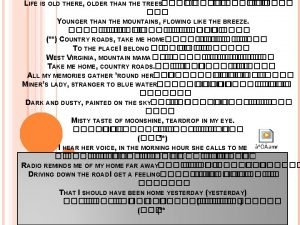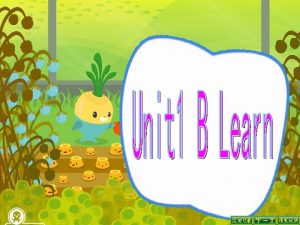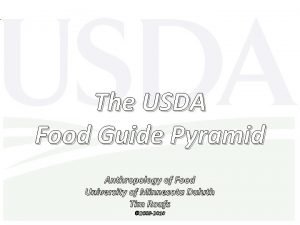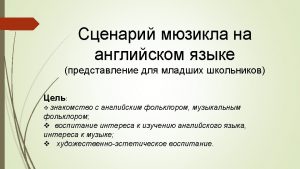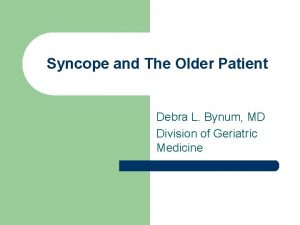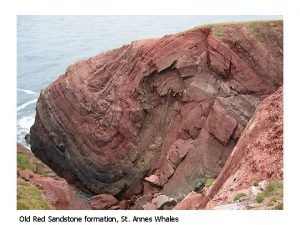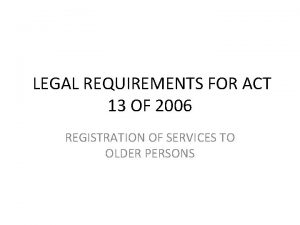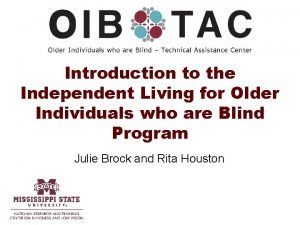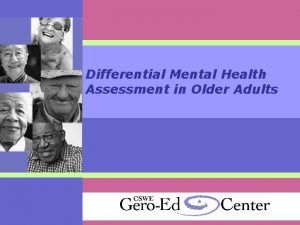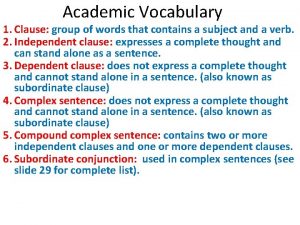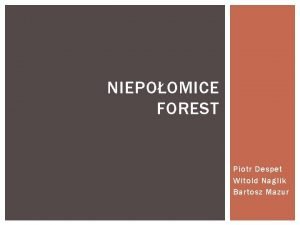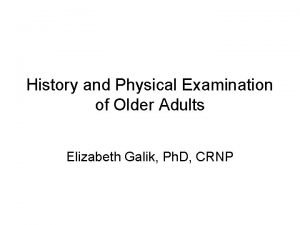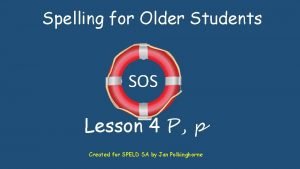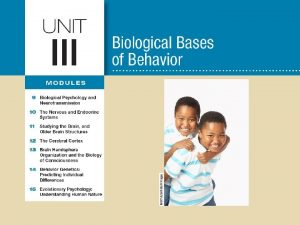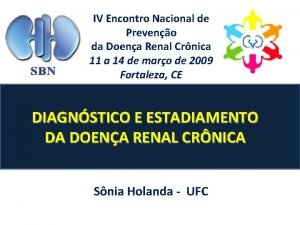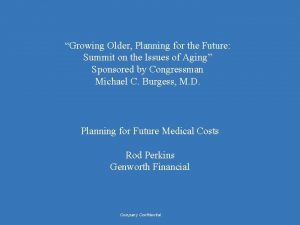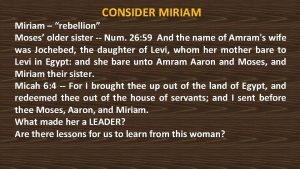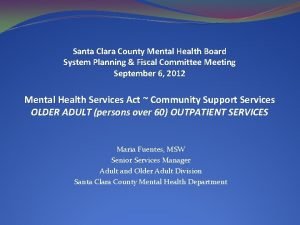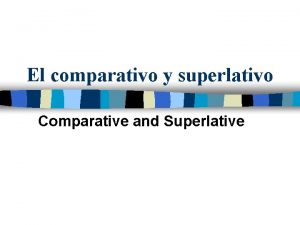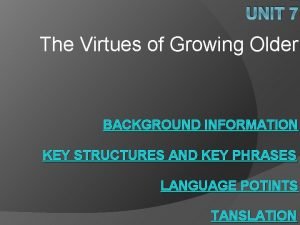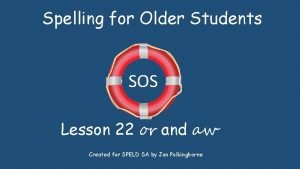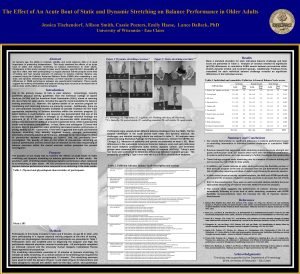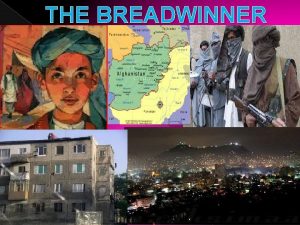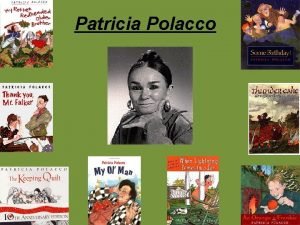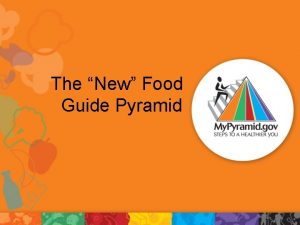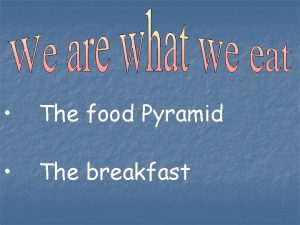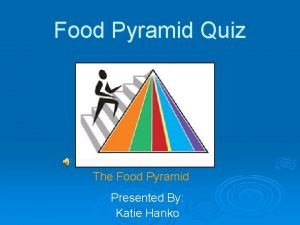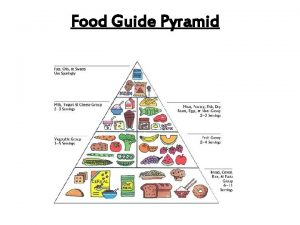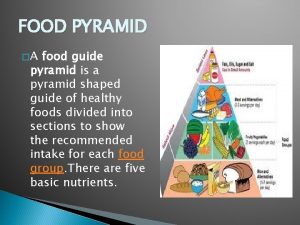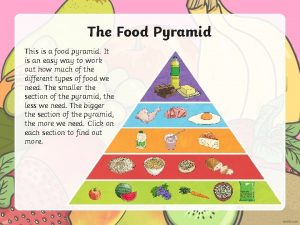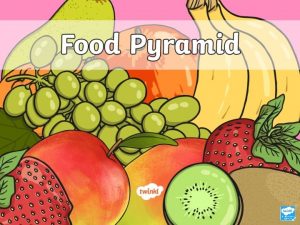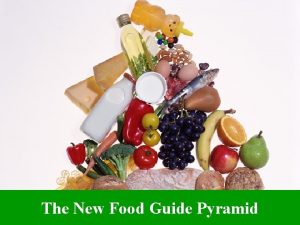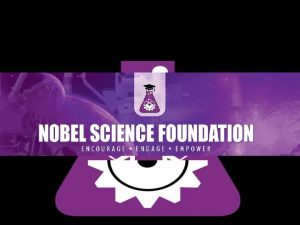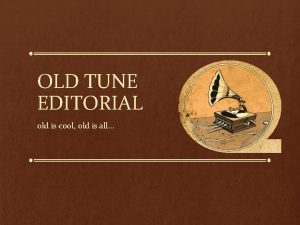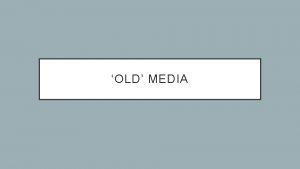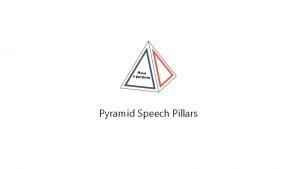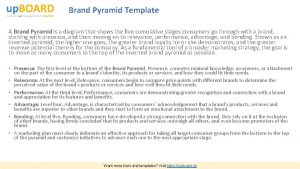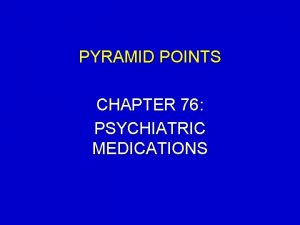The Older Food Pyramid The Old Food Pyramid











































- Slides: 43


The Older Food Pyramid

The Old Food Pyramid


n n My Plate was created to give a more realistic image to what portions and nutrition should look like Most people can relate to a plate

Exercise is Important!!! o Adults should be physically active for 30 minutes most days of the week o 60 -90 minutes to sustain weight loss o Metabolism is the rate at which food is converted into energy in body cells

Calories o A calorie is a measure of the amount of energy released when nutrients are burned o Empty calories are foods that have no nutritional value. (candy, soda, cookies, alcohol, cake)

Grains n n n 6 oz a day make 3 oz whole grains 1 oz is about 1 slice of bread, or 1 cup of breakfast cereal, ½ cup of cooked rice, cereal, or pasta

Vegetables n n dark- green veggies like broccoli and spinach Need 2 ½ cups a day orange vegetables like carrots and sweet potatoes Eat more dry beans and peas like pinto beans, kidney beans, and lentils

Fruits n n Eat a variety of fruit Need 2 cups a day Choose canned, fresh, dried or frozen fruit Go easy on fruit juices

Milk n n n Go low-fat or fat-free Need 3 cups a day If you don’t or can’t consume milk, choose lactose free products or other calcium sources such as fortified foods and beverages

Meats and Beans n n Need about 5 ½ ounces a day Bake it, Broil it, or Grill it Vary your protein routine- choose more fish, beans, peas, nuts, and seeds Choose low-fat or lean meats and poultry

The 6 Basic Nutrients Fats Minerals Water Nutrients Vitamins Carbohydrates Proteins

Nutrients n n n All foods are made up of nutrients A nutrient, is a substance in food that helps with body processes, helps with the growth and repair of cells, and provides energy There are six basic nutrients: Proteins, Carbohydrates, Fats, Vitamins, Minerals, and Water

Nutrients Cont… n n No one food contains all 6 nutrients Nutrient density foods that are packed with nutrients but have low amounts of calories. (fruit, yogurt, whole grain bread, veggies)

Proteins n n Used for growth; building, repairing, and maintaining body tissues; and supplying energy. Proteins contain amino acids There about 20 amino acids but your body only produces 11 out of the 20 The other 9 amino acids that your body does not produce, are called the essential amino acids, the only way to get them is from foods we eat

n n A complete protein contains all of the 9 essential amino acids Foods that are complete proteins are: Meat, Fish, Poultry, Milk, Yogurt, Eggs, and Soybeans

§ n An incomplete protein does not contain all of the 9 essential amino acids Foods that are incomplete proteins come from plant sources n n Ex: grains, peas, nuts, beans, whole grains For those who do not eat foods that are complete proteins, combining 2 or more incomplete proteins is the only way to ensure getting all of the 9 essential amino acids

Proteins in Review n n n Made up of 20 amino acids 11 amino acids are produced by the body The other 9 are called essential amino acids and we get them from food A complete protein contains all 9 essential amino acids An incomplete protein contains some but not all 9 essential amino acids Examples of good protein sources are: meats, poultry, fish, nuts, beans, peas, milk, yogurt, and eggs

Carbohydrates n n n CARBOHYDRATES ARE THE MAIN SOURCE OF ENERGY FOR THE BODY. Your body can store only limited amounts of carbohydrates Excess carbohydrates are converted and stored as fat

Sources of Carbohydrates Include: n n n n n Vegetables Beans Potatoes Pasta Breads Rice Bran Popcorn Fruit

There are 2 types of Carbohydrates n n Simple Carbohydrates are sugars that enter the blood-stream rapidly and provide quick energy. Found naturally in fruits, honey, and milk Also found in processed foods such as; cakes, candy, ketchup, spaghetti sauce, and soda Simple Carbohydrates provide calories but few vitamins and minerals

n n Complex carbohydrates are starches and fibers Sources of complex carbohydrates include bread, pasta, potatoes, and beans Starch is a food substance that is made and stored in most plants Starches provide long-lasting energy

n n Fiber is the part of grains and plant foods that cannot be digested AKA Roughage Fiber helps food move through the digestive system, preventing constipation and intestinal problems Makes you feel full Reduces risk of heart disease, high blood pressure, and cancer

Fiber Cont. . n Women should have 25 g daily n Men should have 38 g daily n n Good sources of fiber include: wheat, bran, cereals, fruit, and vegetables Foods high in fiber contain 2 or more grams per 100 calories

Carbohydrates in Review Carbohydrates Simple Carbohydrates -Provide quick energy -Very little nutritious value • Good Sources of Carbohydrates include: grains, vegetables, potatoes, and beans Complex Carbohydrates Starches Fibers -Provide longlasting energy -Are not digestible -Prevent Disease -Helps to keep digestive system healthy

Vitamins n n n A Vitamin is a nutrient that helps the body use carbohydrates, fats, and proteins Do not supply energy There are 2 types of vitamins: fat-soluble and water-soluble

n n n A fat-soluble vitamin is a vitamin that dissolves in fat and can be stored in the body There are 4 types of fat-soluble vitamins: A, D, E, and K A water-soluble vitamin is a vitamin that dissolves in water and cannot be stored in the body Flush out daily through perspiration and urination which is why you need these daily Examples of water-soluble vitamins are: C and all B

Vitamins in Review n n n Help body use other nutrients 2 types: Fat-Soluble and Water-Soluble Fat-Soluble are stored in the body Water-Soluble are not stored in the body Food is the best way to get vitamins!!!

Minerals n n n A mineral is a nutrient that regulates many chemical reactions in the body Found in rocks and soil and absorbed by plants Required in small amounts

Important Minerals n n n Iron promotes healthy red blood cells and helps to transport oxygen in the body An iron deficiency can lead to anemia, a condition in which the body is unable to produce sufficient red blood cells Good sources of iron include: seafood, green leafy vegetables, lean red meats, and whole grain breads

Important Minerals Cont. . n n n Calcium builds bones and teeth and maintains bone strength Also functions in the contraction of muscles and blood clotting All cells in the body need calcium Good sources of calcium include: milk/milk products, dark green leafy vegetables, dried beans, and nuts Osteoporosis is caused by a calcium deficiency

Important Minerals Cont. . n n n Sodium regulates and maintains the balance of fluids in the body A good source of sodium is table salt Most people can get adequate sodium in their diet without adding extra salt to their food

Minerals in Review n n n Regulate chemical reactions in the body Needed in small amounts Iron helps maintain healthy red blood cells Calcium builds strong bones, helps with blood clotting Sodium maintains balance of fluids in the body

Water • Involved with all body • • • processes, makes up the basic part of the blood, helps to remove waste, regulates body temperature, and cushions the spinal cord and joints. Water makes up 65% of the body mass Leaves the body through perspiration and urine A person can live without other nutrients for months but can survive without water only for about 3 days!!!

Water Cont. . • It is important to drink at least 6 to 8 glasses of water a day • Found in many foods such as fruits and veggies • Soda and coffee should never be substitutes for drinking water

Water in Review • Involved with all body processes • Makes up about 65% of body mass • Need 6 -8 glasses a day

Fats • A fat is a nutrient that provides energy and helps the body store and use vitamins • Stored as tissue that surrounds and cushions internal organs • The body needs fat to maintain body heat, store and use vitamins, maintain an energy reserve, and build brain and nerve tissues

There are 2 main types of Fats • Saturated Fat is a type of fat from dairy products, solid vegetable fat, and meat and poultry • Saturated fats are usually solid at room temperature • Contributes to the level of cholesterol in a person’s blood

• Cholesterol is a fatlike substance made by the body and found in certain foods • A person’s blood cholesterol level can be lowered by eating fewer saturated fats • Maintaining a healthful cholesterol level lowers the risk of heart disease and some cancers

• Unsaturated Fat is obtained from plant products and fish • Usually liquid at room temperature • Examples are: corn oil, sunflower oil, olive oil, canola oil, and soybean oil

Fats in Review • There are 2 types of fats: saturated and unsaturated • Saturated is solid at room temp and can contribute to cholesterol in a person’s blood • Cholesterol is a fatlike substance found in food and in the body • High levels of cholesterol in a person’s blood can lead to heart disease and cancers • Unsaturated fat is liquid at room temp

Antioxidants • Substances found in certain foods that prevent deterioration of cells or counteract damaging effects in the body • Examples are: broccoli, tomatoes, garlic, blueberries, and dark chocolate
 Life is older older than the trees
Life is older older than the trees Tall old people
Tall old people Food pyramid picture
Food pyramid picture What's your name is
What's your name is Once upon a time a little man running
Once upon a time a little man running Once upon a time there lived an old man and an old woman
Once upon a time there lived an old man and an old woman Once upon a time there lived a father
Once upon a time there lived a father Why does organism eat another organism
Why does organism eat another organism Web accessibility for older users
Web accessibility for older users Syncope in the older patient is
Syncope in the older patient is Which is older
Which is older Mental health and older adults
Mental health and older adults Older persons act norms and standards
Older persons act norms and standards Intellectual development in older adulthood
Intellectual development in older adulthood Older individuals who are blind program
Older individuals who are blind program Mental health and older adults
Mental health and older adults Altered cognition in older adults is commonly attributed to
Altered cognition in older adults is commonly attributed to As people grow older
As people grow older Although it was raining maria went for a jog at the park
Although it was raining maria went for a jog at the park The brother of the prodigal son
The brother of the prodigal son Bartosz older owl
Bartosz older owl Shingles older adults
Shingles older adults Downsizing and divesting older business
Downsizing and divesting older business Sos spelling for older students
Sos spelling for older students Patricia polacco brother
Patricia polacco brother Ajayan is ten years older than vijayan
Ajayan is ten years older than vijayan Module 11 studying the brain and older brain structures
Module 11 studying the brain and older brain structures Renal
Renal Future medical
Future medical Which sentence tells you that hoa is older than nien
Which sentence tells you that hoa is older than nien Covids older adults
Covids older adults Moses older sister
Moses older sister Older adults mental health
Older adults mental health Superlativo de blanca
Superlativo de blanca The virtues of growing older
The virtues of growing older Sos spelling for older students
Sos spelling for older students Taller younger sister shorter older brother
Taller younger sister shorter older brother Poem on growing older
Poem on growing older Younger cells cuboidal older cells flattened
Younger cells cuboidal older cells flattened Dynamic stretching for older adults
Dynamic stretching for older adults Breadwinner characters
Breadwinner characters Patricia polacco husband
Patricia polacco husband Older women's cohousing
Older women's cohousing Unit 2 food food food
Unit 2 food food food
